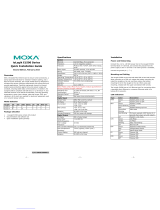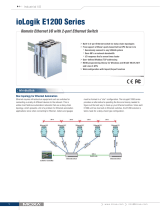
Table of Contents
1. Introduction to the ioLogik E1500 ..................................................................................................... 1-1
Product Features ................................................................................................................................ 1-2
Inside the Box .................................................................................................................................... 1-2
Ordering Information .......................................................................................................................... 1-2
Specifications ..................................................................................................................................... 1-2
Common Specifications ................................................................................................................ 1-2
ioLogik E1510-T .......................................................................................................................... 1-3
ioLogik E1512-T .......................................................................................................................... 1-3
Physical Dimensions ............................................................................................................................ 1-5
Hardware Reference ............................................................................................................................ 1-6
Panel Guide ................................................................................................................................ 1-6
LED Indicators ............................................................................................................................ 1-6
I/O Circuit Diagram ............................................................................................................................. 1-7
Isolation DI (DI channels) ............................................................................................................ 1-7
DI Circuit (DIO channels) ............................................................................................................. 1-7
DO Circuit (DIO channels) ............................................................................................................ 1-7
2. Initial Setup ...................................................................................................................................... 2-1
Hardware Installation .......................................................................................................................... 2-2
Connecting the Power .................................................................................................................. 2-2
Grounding the ioLogik E1500 ........................................................................................................ 2-2
Connecting to the Network ........................................................................................................... 2-2
I/O Wiring Diagrams .................................................................................................................... 2-3
Software Installation ........................................................................................................................... 2-5
Load Factory Defaults .......................................................................................................................... 2-5
3. Using the Web Console ...................................................................................................................... 3-1
Introduction to the Web Console ........................................................................................................... 3-2
Overview ........................................................................................................................................... 3-3
Network Settings ................................................................................................................................ 3-3
General Settings ......................................................................................................................... 3-3
Ethernet Configuration ................................................................................................................. 3-4
User-defined Modbus Addressing .......................................................................................................... 3-4
Default Address .......................................................................................................................... 3-5
Active OPC Server Settings .................................................................................................................. 3-5
Tag Generation................................................................................................................................... 3-5
I/O Settings ....................................................................................................................................... 3-7
DI Channels ................................................................................................................................ 3-7
DO Channels ............................................................................................................................. 3-10
System Management ......................................................................................................................... 3-12
IP Accessibility .......................................................................................................................... 3-12
Network Connection .................................................................................................................. 3-13
Firmware Update ....................................................................................................................... 3-13
Import System Configuration Settings ......................................................................................... 3-13
Export System Configuration Settings .......................................................................................... 3-14
Change Password ...................................................................................................................... 3-14
Load Factory Defaults ........................................................................................................................ 3-14
Save/Restart .................................................................................................................................... 3-15
4. Using ioSearch .................................................................................................................................. 4-1
Introduction to ioSearch ...................................................................................................................... 4-2
ioSearch Main Screen .......................................................................................................................... 4-2
Main Screen Overview.................................................................................................................. 4-2
Main Items ........................................................................................................................................ 4-3
System ...................................................................................................................................... 4-3
Sort ........................................................................................................................................... 4-4
Quick Links ................................................................................................................................. 4-4
Main Function ..................................................................................................................................... 4-4
Locate ....................................................................................................................................... 4-5
Firmware Upgrade ....................................................................................................................... 4-5
Unlock ....................................................................................................................................... 4-5
Import ....................................................................................................................................... 4-6
Export ....................................................................................................................................... 4-6
Change IP Address ...................................................................................................................... 4-7
Batch TCP/IP Configuration of Multiple Devices ............................................................................... 4-7
Restart System ........................................................................................................................... 4-8
Reset to Default .......................................................................................................................... 4-8
Mass Deployment (Import) ........................................................................................................... 4-9
Mass Deployment (export) ........................................................................................................... 4-9






















